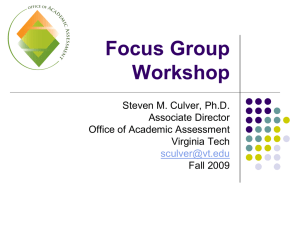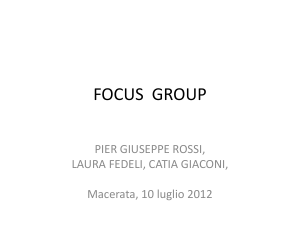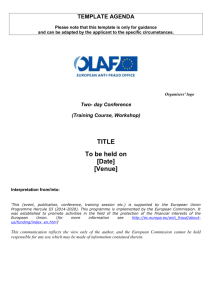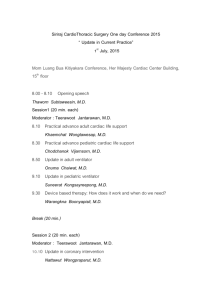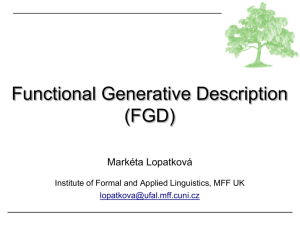Focus Groups 101
advertisement
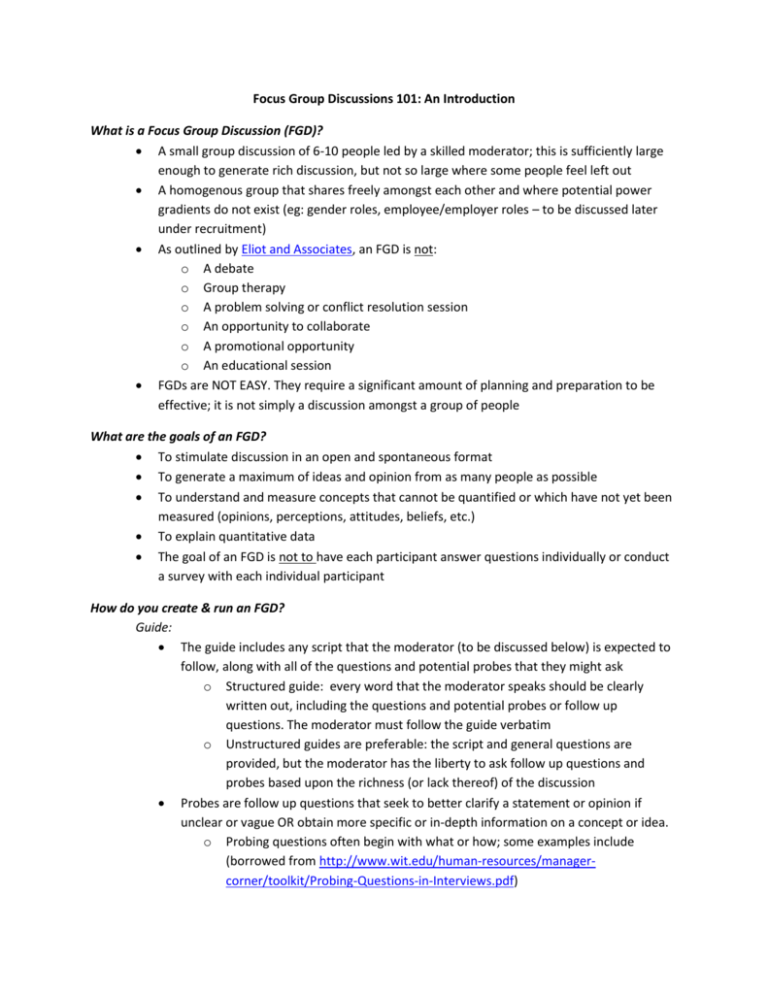
Focus Group Discussions 101: An Introduction What is a Focus Group Discussion (FGD)? A small group discussion of 6-10 people led by a skilled moderator; this is sufficiently large enough to generate rich discussion, but not so large where some people feel left out A homogenous group that shares freely amongst each other and where potential power gradients do not exist (eg: gender roles, employee/employer roles – to be discussed later under recruitment) As outlined by Eliot and Associates, an FGD is not: o A debate o Group therapy o A problem solving or conflict resolution session o An opportunity to collaborate o A promotional opportunity o An educational session FGDs are NOT EASY. They require a significant amount of planning and preparation to be effective; it is not simply a discussion amongst a group of people What are the goals of an FGD? To stimulate discussion in an open and spontaneous format To generate a maximum of ideas and opinion from as many people as possible To understand and measure concepts that cannot be quantified or which have not yet been measured (opinions, perceptions, attitudes, beliefs, etc.) To explain quantitative data The goal of an FGD is not to have each participant answer questions individually or conduct a survey with each individual participant How do you create & run an FGD? Guide: The guide includes any script that the moderator (to be discussed below) is expected to follow, along with all of the questions and potential probes that they might ask o Structured guide: every word that the moderator speaks should be clearly written out, including the questions and potential probes or follow up questions. The moderator must follow the guide verbatim o Unstructured guides are preferable: the script and general questions are provided, but the moderator has the liberty to ask follow up questions and probes based upon the richness (or lack thereof) of the discussion Probes are follow up questions that seek to better clarify a statement or opinion if unclear or vague OR obtain more specific or in-depth information on a concept or idea. o Probing questions often begin with what or how; some examples include (borrowed from http://www.wit.edu/human-resources/managercorner/toolkit/Probing-Questions-in-Interviews.pdf) Could you tell more about that? Does everyone agree? So what I hear you saying is…? You just told me about…, I’d also like to know about… The guide should be developed to keep the discussion to between 45 minutes and an hour. Anything over an hour and the participant’s interest will begin to wane Questions should be open-ended or sentence completion type questions. Try to avoid: o Yes/no questions o Threatening or embarrassing questions o Long, ambiguous questions The basic format of a guide is: o Consent & Introductions/Ice Breaker o Engagement Questions: soft-ball questions that are low-risk, easy for everyone to answer, warm the group up, and prepare them for the topic of discussion o Exploration Questions: the purpose of the discussion o Exit Questions: explore anything that might have been missed, wrap up the discussion Sampling/Recruitment: there is no hard and fast approach to selecting people to participate in an FGD. It depends upon the purpose of the research and access to the study population It is always recommended to create homogenous groups, where people feel comfortable, but do not necessarily know each other Inclusion and exclusion criteria should always be determined well in advance and communicated clearly in any study protocols and to the participants themselves When selecting participants in an FGD, you will want to consider any potential power dynamics that will inhibit participants. These can include (not a comprehensive list): o Age o Gender o Race/Ethnicity o Religious beliefs o Social and economic status o Educational attainment Some possible methods for identifying participants: o Nomination (also known as snow-ball sampling): where one person recommends another person or persons who then recommends additional people o Random sampling o Volunteers: take anyone that is available o People from existing groups or similar job titles/roles (also can be referred to as purposive sampling) Identify a neutral and convenient location where all participants will feel comfortable meeting. Clearly communicate the starting time (it is recommended to tell people to show up 15 minutes prior to the actual planned time) and ensure that participants expect 1.5-2 hours of discussion When appropriate, provide snacks, meals and beverages o For a needs assessment it is not recommended to provide cash incentives, but if an FGD is used for pure research, then cash incentives might be appropriate Name tents or badges should be provided so that everyone can refer to each other by their first names It is always recommended to collect de-identified demographic data o Consider developing a short questionnaire or matrix that can be completed before or at the start of the discussion Roles: to successfully run an FGD, you need at least 2 individuals with nominal training; a moderator and an assistant. Moderator: the role of the moderator is to lead the discussion. The moderator should: Be an active listener who can be empathetic when necessary Able to listen, think and write at the same time Encourage all participants to talk and engage in the discussion Take notes about the discussion as it unfolds, noting probes, follow-ups and issues with the guide. This is data and should be incorporated into interpretations and analysis Have adequate knowledge about the topic Be someone the group can relate to, but also serve as an authority figure Be able to effectively manage group dynamics and facilitate effective discussions Assistant: the role of the assistant is to take notes on the discussion and manage time. The assistant must: Develop a discussion map, where each participant is given a number based upon where they are sitting. During note taking, each participant should be referred to by their number on the map to save time Keep comprehensive notes as a back-up to the voice recorder; tracking who says what and when using the map as reference. This is the only way to transcribe the recordings and will be the only source of data if the recorder fails, is lost or damaged Note all verbal and non-verbal communication or cues o Includes slouching, facial expressions, coughs, crying, sneezing, arms crossed, etc. This is all data and should be noted Keep track of time and manage the voice recorder NOT talk or ask questions during the discussion. This is the role of the moderator only Reflection: after the discussion, complete two separate reflections. This generates more data that can be used for interpretation and process improvement The moderator and the assistant should reflect on the discussion separately, taking notes on the highlights, challenges, issues with questions, and any major themes that they felt emerged from the discussion Then come together so the moderator and assistant share their individual reflections. Notes should be taken. How do you analyze data from an FGD? Transcripts: all recordings should be transcribed as soon as possible after the discussion. Transcripts are the data from an FGD. If the discussions are poorly transcribed and the accompanying notes are poorly taken, then the data will be limited Transcripts should be verbatim recreations of the discussions They should include all questions, answers, discussions, comments, coughs, sneezes and non-verbal cues/communication noted by the assistant See Appendix 1 for symbols that can be used when transcribing Coding: to analyze qualitative data (words and narrative) it is necessary to create a framework to identify text, compare text to other text, and sometimes to quantify the frequency of words, narrative or concepts. This is called coding. A code is a word or short phrase that captures the essence, main idea or theme for a portion of language or narrative. Codes are used to capture ideas, thoughts or themes that are as small as a single word, a couple of lines of text, a paragraph or an entire page of text A code book is a compilation of all the codes developed to analyze transcripts. It includes: o The codes o The definition of each code o How a code should be used/applied Code books should be developed collaboratively amongst all individuals involved in the research (moderator, assistant moderator, PI, research assistants, etc.) o The moderator and assistant should keep track of potential codes/themes/ideas during the FGDs and reflections o The entire team should meet to discuss and agree upon all potential codes, definitions and uses before any coding takes place There is now software available to facilitate the coding and analysis of qualitative data. The most commonly used are NUDIST, MAXQDA and AnSWR (free). Analysis: to analyze qualitative data, it is necessary to explore the relationships between the codes. Analysis strategies depend upon the purpose of the research, the type and quality of the data. The two most common are an emergent them analysis and a question-based analysis. Appendix 1: A Sample of Transcription Symbols [ ] (2.4) (.) wo() word… ((word)) Word Starting point of overlapping speech End point of overlapping speech Silence measured in seconds Pause of less than (0.2) seconds Cut off in the middle of a word Inaudible word When the speaker slowly trails off in a sentence Transcriber’s comments Moderators/Interviewer’s comments/questions Include any other sounds that are necessary in the transcripts. These can include laughter, throat clearing, coughing, crying, birds, interruptions from outside people, anything and everything that might affect the process of data collection.
